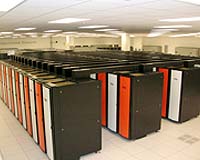 |
London, UK (SPX) Mar 31, 2010 University students have developed a computer game that is operated by eye movements, which could allow people with severe physical disabilities to become 'gamers' for the first time. The students, from Imperial College London, have adapted an open source game called 'Pong', where a player moves a bat to hit a ball as it bounces around the screen. The adaptation enables the player to move the bat using their eye. To play the game, the user wears special glasses containing an infrared light and a webcam that records the movement of one eye. The webcam is linked to a laptop where a computer program syncs the player's eye movements to the game. The prototype game is very simple but the students believe that the technology behind it could be adapted to create more sophisticated games and applications such as wheelchairs and computer cursors controlled by eye movements. One of the major benefits of the new technology is that it is inexpensive, using off-the-shelf hardware and costing approximately Pounds 25 to make. Eye movement systems that scientists currently use to study the brain and eye motion cost around Pounds 27,000, say the researchers. Dr Aldo Faisal, the team's supervisor from the Department of Computing and the Department of Bioengineering at Imperial College London, says: "Remarkably, our undergraduates have created this piece of neurotechnology using bits of kit that you can buy in a shop, such as webcams. The game that they've developed is quite simple, but we think it has enormous potential, particularly because it doesn't need lots of expensive equipment. "We hope to eventually make the technology available online so anyone can have a go at creating new applications and games with it and we're optimistic about where this might lead. We hope it could ultimately provide entertainment options for people who have very little movement. In the future, people might be able to blink to turn pages in an electronic book, or switch on their favourite song, with the roll of an eye." Mr Ian Beer, who is a third year undergraduate from the Department of Computing, adds: "This game is just an early prototype, but we're really excited that from our student project we've managed to come up with something that could ultimately help people who have really limited movement. It would be fantastic to see lots of people across the world creating new games and applications using our software." Researchers in Dr Faisal's lab are now refining the technology so that it can monitor movements in both eyes. This would enable a user to carry out more complicated tasks such as plotting a journey on screen. This might ultimately allow them to use eye movements to steer a motorised wheelchair.
Share This Article With Planet Earth
Related Links Video demonstrating how the computer game works Imperial College London Space Technology News - Applications and Research
 Australia commissions Cray supercomputer
Australia commissions Cray supercomputerCanberra, Australia (UPI) Mar 19, 2009 Australia's Defense Department has commissioned a Cray supercomputer as part of its ramping up of terrorist intelligence gathering. Australian Minister for Defense Personnel, Materiel and Science Greg Combet made the announcement but gave no details of the computer, which sits within the Defense Signals Directorate. "The new supercomputer delivered by Cray Incorporated supports D ... read more |
|
| The content herein, unless otherwise known to be public domain, are Copyright 1995-2010 - SpaceDaily. AFP and UPI Wire Stories are copyright Agence France-Presse and United Press International. ESA Portal Reports are copyright European Space Agency. All NASA sourced material is public domain. Additional copyrights may apply in whole or part to other bona fide parties. Advertising does not imply endorsement,agreement or approval of any opinions, statements or information provided by SpaceDaily on any Web page published or hosted by SpaceDaily. Privacy Statement |